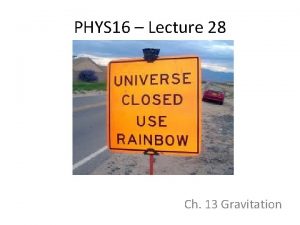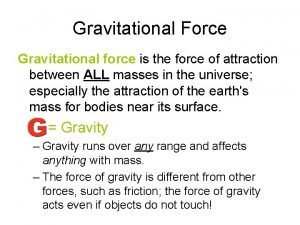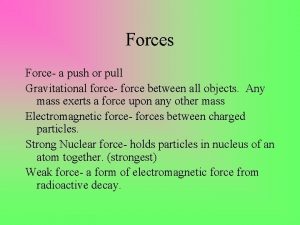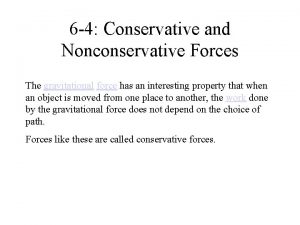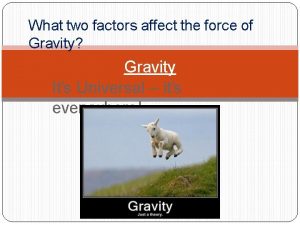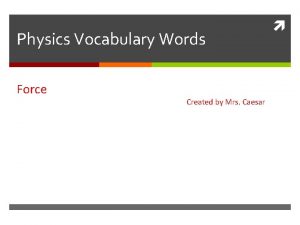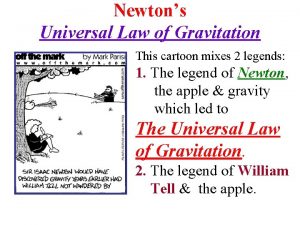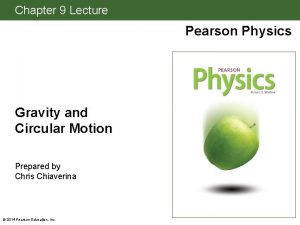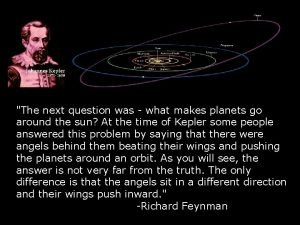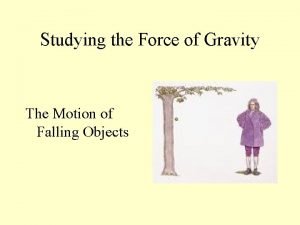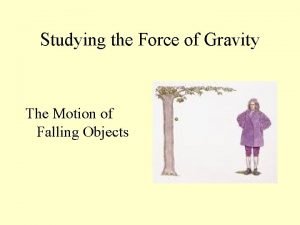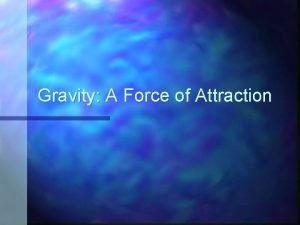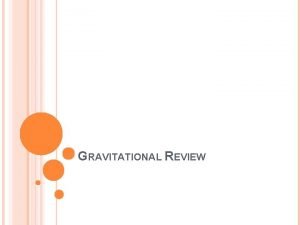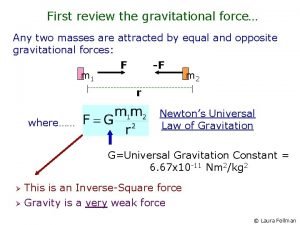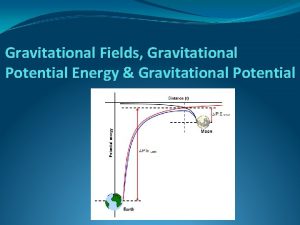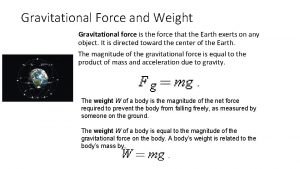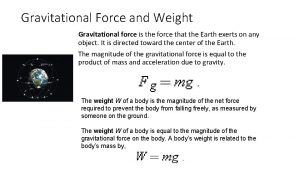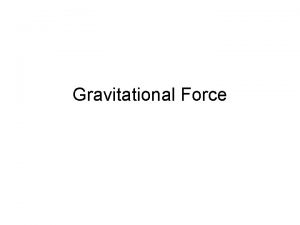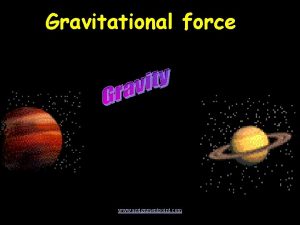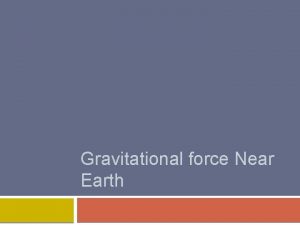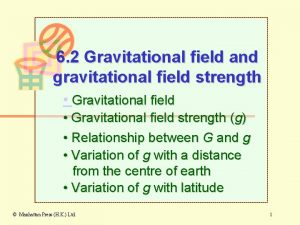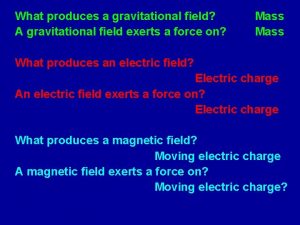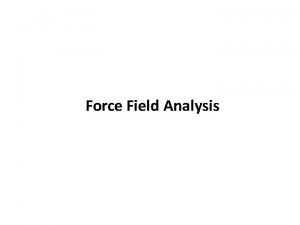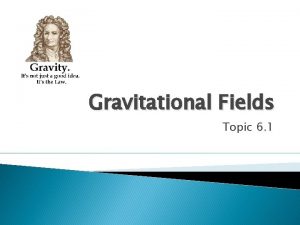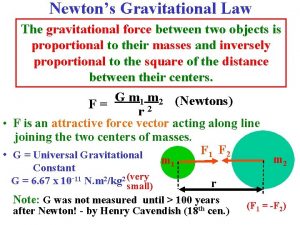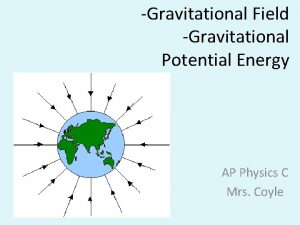Gravitational Field Gravitational Force Action at a distance




















- Slides: 20

Gravitational Field & Gravitational Force

“Action at a distance” The gravitational force is an attractive force between two masses. Gravity is a field force. The masses don’t need to be in contact with each other to cause attraction.

Backpack, apples, ect. Jumping with a large backpack on is a lot harder than jumping with a small backpack on. Why? Gravity must have something to do with the mass of the object (ie. Backpack)

Backpack, apples, ect. Earth, moon, … Dropping an object on Earth is different than dropping that same object on the moon. The object will fall to the ground in both scenarios, but the rates are different. Why? The moon is less massive than the Earth, so falling (caused by gravity) must be directly related to the mass of one object (the Earth or the moon) causing a second object (an apple, a ball) to fall.

What about distance between the two masses? It turns out, the gravitational force decreases with distance, but not linearly. If you double the distance between two objects the force of gravity between them decreases by a factor of 4. If you quadruple the distance between two objects, the force of gravity decreases by a factor of 16! This is the inverse square law:

So what is gravity? Gravity is the force of attraction between two masses. Where: G = Universal Gravitational Constant = 6. 67 x 10 -11 N. m 2/kg 2 M 1 = Mass of one object (in kg) m 2 = Mass of other object (in kg) r = distance between objects (measured center to center in meters)

Example: Determine the force of gravitational attraction between the earth (m = 5. 98 x 1024 kg) and a 70. kg physics student flying in an airplane 40000 ft (12, 000 m) above the surface of the Earth (radius of Earth = 6. 3781 x 106 m). M 1 = 5. 98 x 1024 kg m 2 = 70. kg r = 12, 000 m + 6. 3781 x 106 m = 6. 3901 x 106 m Fgravity = 683. 77 ~ 680 N

Field Force Gravity is a field force, meaning the two masses will attract each other even when they aren’t in contact with each other. This force of attraction will cause the masses to accelerate towards each other. Masses create gravitational fields around themselves. Any other mass in that gravitational field will experience a force of attraction. It is this gravitational field that causes gravity to be able to act at a distance on other masses.

Earth’s Gravitational Field Any object near the surface of the Earth will accelerate towards the Earth at 9. 8 m/s 2 Any object that is 3. 8 x 108 m from the surface of the Earth will accelerate towards the Earth at 0. 00272 m/s 2

Calculating Gravitational Fields: Where: g = gravitational field G = Universal Gravitational Constant = 6. 67 x 10 -11 N. m 2/kg 2 M 1 = Mass of the object CREATING the field (in kg) r = distance from the center of the object creating the field to the point you are looking at. Units:

Calculate Earth’s Gravitational Field. MEarth = 5. 98 x 1024 kg & radius of Earth = 6. 3781 x 106 m g = 9. 80 m/s 2

A satellite is halfway between the Earth and the moon. What is the net gravitational field at that location. MEarth = 5. 98 x 1024 kg 1. 9 x 108 m Mmoon = 7. 36 x 1022 kg 1. 9 x 108 m = 0. 0109 N/kg

What does a gravitational field of 0. 0109 N/kg mean? Any object placed at that location will accelerate towards the Earth at 0. 0109 m/s 2 regardless of it’s mass. It will also let us calculate the force of gravity on any object placed at that location using F = mg This mass CREATES the Gravitational field “g” This mass EXPERIENCES the Gravitational field The Gravitational field

Back to the satellite: If a 150 kg satellite is placed in orbit halfway between the Earth and the moon, what will the force of gravity be on the satellite? g = 0. 0109 N/kg Fgravity = mg Fgravity = (150 kg)(0. 0109 N/kg) Fgravity = 1. 6 N

The satellite is in orbit around the Earth (instead of floating off in a straight line towards Jupiter). What is the magnitude/strength of the centripetal force? This is what we will be talking about tomorrow… Fgravity = 1. 6 N

How do the tides work?

What we already know: The water under the moon is closer to the moon than the center of the Earth is. So the moon’s gravity pulls harder on the water and the water “heaps up” under the moon.

But what about the bulge on the other side?

The New Part: The center of the Earth is closer to the moon than the water on the OPPOSITE side of the Earth. The moon pulls the Earth away from the water, and it appears to “heap up” too.

 Centripetal force and gravitational force
Centripetal force and gravitational force Normal force and gravitational force
Normal force and gravitational force Force
Force Gravitational field ragnarok
Gravitational field ragnarok Gravitational field
Gravitational field Gravitational acceleration
Gravitational acceleration Gravitational force quick check
Gravitational force quick check What is gravitation
What is gravitation Is gravitational force a push or pull
Is gravitational force a push or pull The force of gravitation is conservative or nonconservative
The force of gravitation is conservative or nonconservative What two factors determine the force of gravitational pull?
What two factors determine the force of gravitational pull? Gravitational force is a
Gravitational force is a Newton's third law cartoon
Newton's third law cartoon Symbol for the gravitational force
Symbol for the gravitational force Applications of gravitational force
Applications of gravitational force Kepler's law of planetary motion formula
Kepler's law of planetary motion formula Air resistance and surface area
Air resistance and surface area Effects of gravitational force
Effects of gravitational force What is the effect of gravitational force
What is the effect of gravitational force Units to measure acceleration
Units to measure acceleration What is gravitational force
What is gravitational force
